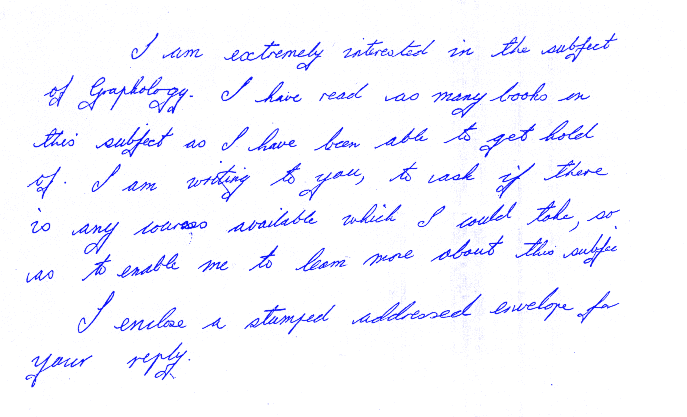
| Every day, each one of us (student as well as professional graphologist), has the opportunity to learn something new about handwriting analysis. Each time we see a piece of writing, we are looking at a unique set of characteristics. The quantity and quality of the writing movements and how they fit together will always be different. |
| a. stimulate interest from the beginner to the professional - I shall use three levels of interpretations and they will be aimed at the first year student, the intermediate student and finally the professional graphologist. This will give you the opportunity to take what you need. Sometimes it can be really helpful to go back to the beginning and look at the fundamental meaning of a movement, whereas at other times a more advanced level is where you will find what you are looking for. |
| b. help students look at how individual writing movements fit into making the unique factor of each writer. |
| NB This does not take the place of a class or correspondence course where your teacher will explain how to observe correctly the writing movements and give general interpretations. |
| c. promote a deeper understanding of the human character - We shall look at a movement and see how the writer has chosen to use it in their personality. Yes, I say chosen, for we are all the owners of our characters. |
| There is no such thing as the perfect parent and as children we choose our own way of surviving. As adults, we have the opportunity to look at our strengths and weaknesses. We can then choose to change what we don't like or alternatively we can accept what we do not wish to change. |
| Pressure, spacing and rhythm are three vital movements which occur in every type of script. With the accurate observation and interpretation of these movements, it is possible to produce an analysis. |
| Pressure is the energy available and how we use it, spacing shows how we relate to the environment in which we live and rhythm shows how we accept ourselves. |
| In this article we shall look at pressure - the indentation into the paper. Why is pressure so vital? Without energy, life is non-existent. |
| Pressure is one of the most difficult movements to assess because there is little opportunity, when learning by correspondence, to work with "live" samples. When does light pressure become medium and medium become heavy, and heavy pressure become too heavy? |
| The first thing to establish is what pressure you have yourself. With this piece of information, you can then begin to learn the other strengths of pressure. |
| It is interesting to note that if you have very light pressure, you may think that someone with medium pressure has heavy pressure. On the other hand if you have very heavy pressure, you may think that someone with medium pressure has light pressure. |

| marked right slant connectedness mainly wide word spacing sharpness narrowness irregular baseline no right margin in places. |
| Beginner Light pressure indicates that the writer in this sample has limited use of her energy and the marked right slant, connectedness and mainly wide word spacing show us that she prefers to work without interruption on one thing at a time. |
| Intermediate Light pressure shows us that the writer is using her energy negatively, allowing oversensitivity to use up vital energy which could be put to better use positively, if she chose to change her attitude. Light pressure with the sharpness and the narrowness in the writing indicates that she likes to use all her energy to do one thing at a time. If she is interrupted she can waste the remaining energy feeling annoyed that she has been disturbed (see the moodiness in the irregularity of the baseline). This results in her blaming other people when she is late in finishing a task (sometimes no right margin and marked right slant especially towards the right side of the page). |
| Professional The light pressure affects her energy in the work place because, with the overconnectedness it makes her inflexible. The marked right slant and the overconnectedness with the light pressure show that she is indecisive and has difficulty choosing whether to use her logic (connectedness) or her emotion (marked right slant) when making a decision that involves both heart and head. |
| It also affects her work because with light pressure and overconnectedness she is going to have difficulty being practical - not wanting to leave a task unfinished, when something of a higher priority needs to be tackled first. |
| For general information on graphology courses run by Jacqui Tew please Click Here |
EMAIL..........................your orders, comments or questions